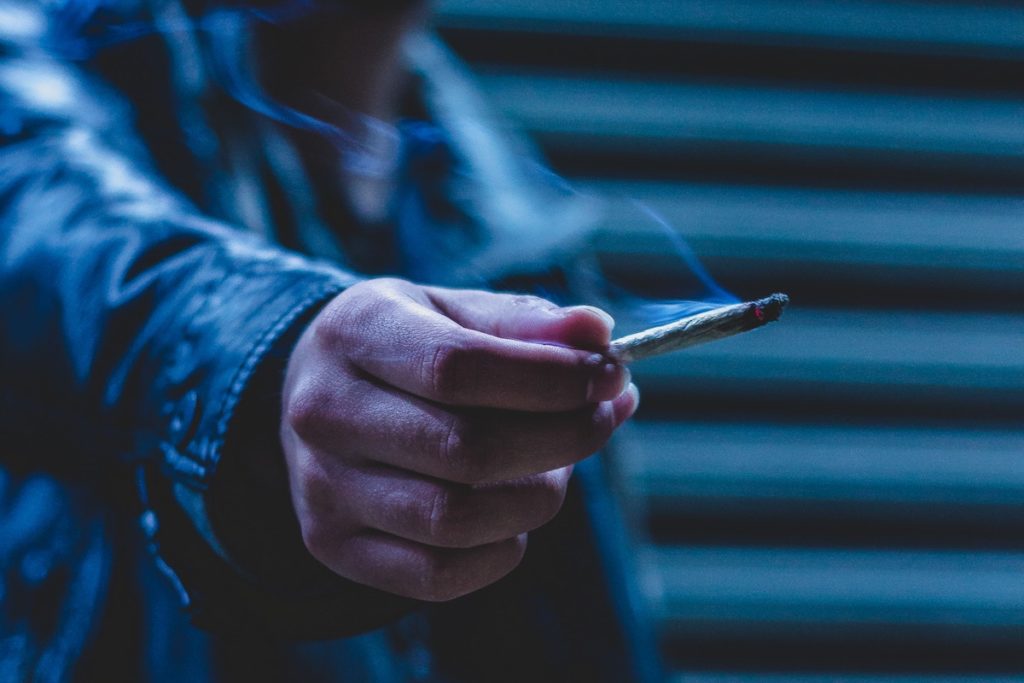
In Western Europe, research has consistently shown that ethnic minorities experience higher rates of psychotic disorders than reference populations (Termorshuizen et al., 2022); the rate going as high as nearly double.
A well known environmental risk factor is the usage of cannabis (Gage, Hickman, and Zammit, 2016), along with other recreational drugs such as cocaine and stimulants (Roncero et al., 2014). Two earlier studies (Cantwell et al., 1999; Veen et al., 2002) have compared cannabis use between migrant and reference populations a year before patients experienced psychosis. However, both failed to include healthy controls, limiting their ability to assess causality between cannabis use and elevated psychosis risk in minority populations.
Selten et al. (2024) attempt to bridge this gap by introducing a control group to test whether cannabis use explains the elevated psychosis risk among non-Western minorities. Their study broadly asks two questions:
- Are there differences between cannabis use in non-Western minorities and the reference population within the control group?
- Does cannabis use explain the higher rates of psychotic disorders observed in non western minorities?

Cannabis is a risk factor for the development of psychosis, but does it explain why some groups experience psychosis more?
Methods
The study used a case-control design, i.e comparing healthy and patient groups to understand the effect of the exposure (cannabis-use) on the outcome (first-episode psychosis). Participants from five countries were included; cases were adults diagnosed with first-episode psychosis using ICD-10 criteria via local psychiatric services. Controls were recruited to reflect local demographic make-up. In the UK sample, Black-African and Black-Caribbean individuals were deliberately oversampled to enable subgroup analysis, then statistically weighted to maintain representativeness (Selten et al., 2024) and were weighted lower to avoid skewing overall results. The final sample analysed 825 cases and 1,026 controls.
Detailed history of cannabis usage was taken using an adapted Cannabis Experience Questionnaire, including other drugs used (Di Forti et al., 2019). Ethnicity was recorded via the Medical Research Council Socio-demographic Schedule (Mallett, Leff, Bhugra, Pang, & Zhao, 2002) detailing the individual’s and their parents’ birthplaces and self-identified ethnicity (Selten et al., 2024).
The study calculated odds ratios for developing psychotic disorders with and without adjusting for different factors of cannabis use in case and control populations by running logistic regressions.
Results
The ethnic minorities were further divided into Western and non-Western based on region of origin to facilitate more detailed analyses. Western minorities included people from the US, Canada, Australia, New Zealand and former USSR nations with christianity as their predominant religion. All others were considered non-Western ethnic minorities (Selten et al., 2024).
To analyse cannabis use within controls, 13 regressions were run: seven between the entire control group, and six between those who had used cannabis before. Paradoxically, non-Western minorities were 48% less likely to have used cannabis in their lifetime compared to Western controls, yet among users, riskier consumption patterns were observed. However, among those that had used cannabis, non-western minorities were more likely to be currently using, do so daily, be aged below 15 when they first tried it, and also to be spending more than 20 Euros a week on buying it.
In line with previous findings, the study observed that the odds of non-western minorities developing psychotic disorders is higher than the reference population. Non-Western minorities had an 80% greater risk of developing psychosis compared to reference populations (OR = 1.80), regardless of cannabis use patterns. More importantly, adding controls in the regression for any of the factors of cannabis usage did not change the odds ratio significantly. The study then controlled for the confound of stimulant and cocaine usage, and found a near negligible change in the odds ratio for non-western minorities developing psychotic disorders. This indicates that the use of cannabis, or even stimulants and cocaine, are not factors responsible for the higher odds of non western ethnic minorities developing psychotic disorders.
A few exceptions to this finding were the odds ratios of some non western minorities in some regions. An exception emerged in London, where adjusting for high-potency daily cannabis use reduced the psychosis risk for African-Caribbean individuals by 35%.

While overall cannabis use didn’t explain elevated psychosis risk in minorities, certain regional patterns indicate localised cannabis effects.
Conclusion
The authors conclude that overall, cannabis use does not explain the higher incidence of psychotic disorders in non western minorities. While some regional subgroups (e.g., African-Caribbeans in London) show cannabis as a contributing factor, the broader trend suggests cannabis is not the main explanatory variable. The authors suggest that social determinants, such as discrimination and systemic stress, may more plausibly underlie ethnic disparities in psychosis rates.

The study concludes cannabis is not the primary driver of higher psychosis risk in ethnic minorities, pointing instead to underlying social determinants.
Strengths and limitations
The study’s use of the CEQ adds granularity, capturing frequency, type, and economic expenditure, elements often missed in prior research (Di Forti et al., 2019). The study further calculated potency of the drug using publicly available data as a factor within the analysis (Selten et al., 2024). The strength of the dose, along with its frequency provides crucial context to one’s cannabis usage. Another strength lies in disaggregating non-Western minorities by region and subgroup, which uncovers localised nuances, whilst it also did not treat non-Western minorities as a monolith. The authors instead divided analysis on the basis of region of collection and sub-groups, which helped find small exceptions to the overall findings of the study, adding a nuance to the current research’s understanding of the relationship between psychosis risk and ethnicity.
However, a limitation is potential sampling bias; ethnic minorities often underutilise psychiatric services due to mistrust and prior negative experiences. Many individuals belonging to ethnic minorities often report disproportionately negative experiences with healthcare systems across the world. Common grievances include misdiagnosis, substandard quality of care, and a disregard of informed consent processes (Kaiser Family Foundation, 2022). Ethnic minorities, therefore, often do not access psychiatric services willingly, making the sample of the study possibly not reflective of the true population the authors were trying to study. Furthermore, the study itself reports the possibility of an under-reporting usage of cannabis due to stigma around substances. The absence of propensity score matching increases susceptibility to unaccounted confounds like socioeconomic status, which may influence both cannabis use and psychosis. This is relevant because the authors themselves attribute the higher incidence rates of psychotic disorders in non western minorities to social factors.

The study’s strengths lie in nuanced cannabis data and subgroup analysis, but limitations in sampling and confounding variables temper generalisability.
Implications
From personal experience, the question of the role of cannabis use around psychosis is a loaded and nuanced issue to explore. Personal narratives illustrate how cannabis use can be misunderstood or overly pathologised in clinical settings. My friend experienced their first episode of psychosis shortly after using cannabis and was treated very poorly by both the medical team that first treated them and their psychiatrist that they had been going to for a long time. Why? Because everyone felt like they had their answer right there; substance use. Nevermind that they had been experiencing paralysing levels of stress and anxiety in the past few weeks, or the traumatic incident that had just occurred in their life; all things that are big risk factors for psychosis (Freeman & Fowler, 2009). Stigma surrounding cannabis use is real, and these negative perceptions can easily compound with the other negative perceptions people have of minority groups. The implications of this study lend themselves greatly to further research and clinical practice.
Clinically, such studies can help deconstruct biases and inform more culturally nuanced, evidence-based care. Plus, the findings also highlight that ethnic minorities are not a homogenous unit. Although the larger experience of being a migrant or numerical minority may be common between communities; the kind of stereotypes about them, their experiences of discrimination, even the likelihood of being able to access higher education and certain jobs can be vastly different for different ethnic groups, that we simply cannot have an umbrella approach for the needs of all these groups.
Future research should pivot toward structural and social causes while also exploring high-risk cannabis use in specific minority groups via larger, localised studies.
- It closes one door in order to open another; by answering the question about cannabis use, this study encourages future researchers to look into social factors that may be contributing to the high incidence rates of psychotic disorders in ethnic minorities.
- The study sets up a good starting point into working with the certain groups whose risk of developing psychotic disorders is being affected by marijuana use; there needs to be replication studies with larger sample sizes for those groups. It provides a clearer focus and question for future researchers that might be interested in exploring the exceptions within the results of the current study. If those larger replication studies find similar results, that data could aid better policy and targeted prevention/treatment strategies for the ethnic minority groups in areas such as Amsterdam and London.

Clinicians and researchers should shift focus toward social risk factors and individual subgroup needs, avoiding blanket assumptions about cannabis and ethnicity.
Links
Primary Paper
Selten JP et al (2024). The contribution of cannabis use to the increased psychosis risk among minority ethnic groups in Europe. Psychological Medicine 1–10.
Other References
Termorshuizen, F., van der Ven, E., Tarricone, I., Jongsma, H. E., Gayer-Anderson, C., Lasalvia, A., … Selten, J. P. (2022). The incidence of psychotic disorders among migrants and minority ethnic groups in Europe: Findings from the multinational EU-GEI study. Psychological Medicine, 52(7), 1376–1385. doi:10.1017/S00332917200032
Gage, S. H., Hickman, M., & Zammit, S. (2016). Association between cannabis and psychosis: Epidemiologic evidence. Biological Psychiatry, 79(7), 549–556. doi:10.1016/j.biopsych.2015.08.001
Roncero, C., Daigre, C., Grau-López, L., Barral, C., Pérez-Pazos, J., Martínez-Luna, N., & Casas, M. (2014). An international perspective and review of cocaine-induced psychosis: A call to action. Substance Abuse, 35(3), 321–327. doi:10.1080/08897077.2014.933726
Cantwell, R., Brewin, J., Glazebrook, C., Dalkin, T., Fox, R., Medley, I., & Harrison, G. (1999). Prevalence of substance misuse in first-episode psychosis. British Journal of Psychiatry, 174, 150–153. doi:10.1192/bjp.174.2.150
Selten, J. P., Bosman, I. J., de Boer, D., Veen, N. D., van der Graaf, Y., Maes, R. A., & Kahn, R. (2002). Hair analysis for cannabinoids and amphetamines in a psychosis incidence study. European Neuropsychopharmacology, 12(1), 27–30. doi:10.1016/s0924-977x(01)00129-8
Di Forti, M., Quattrone, D., Freeman, T.P., Tripoli, G., Gayer-Anderson, C., & Quigley, H. … EU-GEI WP2 Group (2019). The contribution of cannabis use to variation in the incidence of psychotic disorder across Europe (EU-GEI): A multicentre case-control study. The Lancet. Psychiatry, 6(5), 427–436. doi:10.1016/S2215-0366(19)30048-3
Mallett, R., Leff, J., Bhugra, D., Pang, D., & Zhao, J. H. (2002). Social environment, ethnicity and schizophrenia. A case-control study. Social Psychiatry and Psychiatric Epidemiology, 37(7), 329–335. doi:10.1007/s00127-002-0557-4, Erratum in: Social Psychiatry and Psychiatric Epidemiology, 37(8), 399.
Freeman D, Fowler D. Routes to psychotic symptoms: trauma, anxiety and psychosis-like experiences. Psychiatry Res. 2009 Sep 30;169(2):107-12. doi: 10.1016/j.psychres.2008.07.009. Epub 2009 Aug 22. PMID: 19700201; PMCID: PMC2748122.
Kaiser Family Foundation. (2022). Racial and ethnic disparities in mental health care: Findings from the KFF survey of racism, discrimination, and health.
Tavilla, S. (2021). We can’t ignore the racist roots of cannabis criminalization any longer. The Vermont Cynic.
CollegeHumor. (2018). The truth about weed [Video].
The Guardian. (2019). “Pot etiquette: What’s the polite way to use cannabis?”
Kirby, J., Frazetta, F., Siegel, J., Shuster, J., Robinson, J., & Yoe, C. (Ed.). (2018). Reefer madness. Dark Horse Comics.







